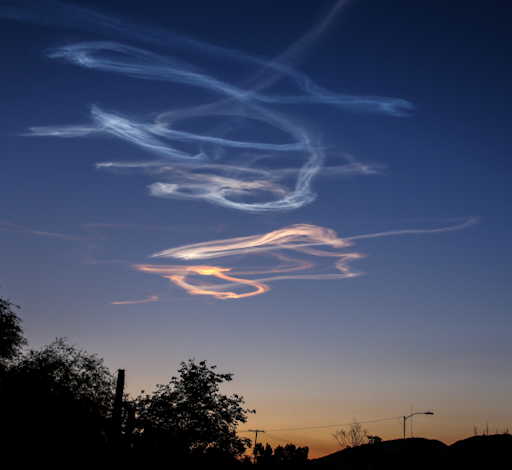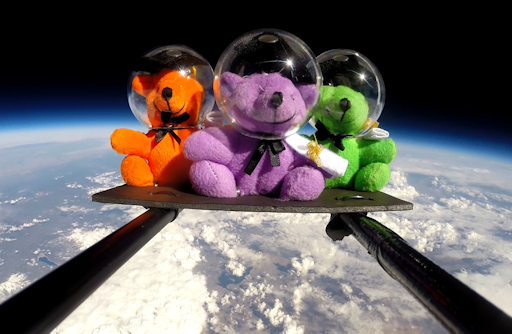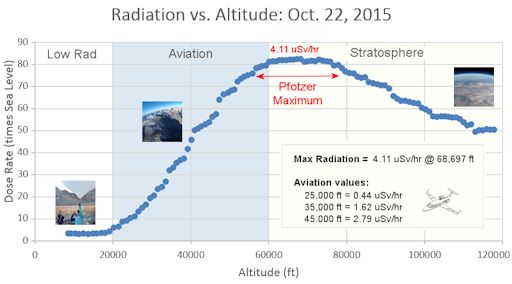It's waiting for you: The most successful Aurora Photo Tour on Earth! 100% success rate 4 years in a row and winner of the TripAdvisor Certificate of Excellence Award. Join LapplandMedia's aurora tours in Abisko, Swedish Lapland! | | |
WEEKEND STORMS ARE LIKELY: NOAA forecasters estimate a 70% chance of geomagnetic storms on June 4th and 5th when a solar wind stream hits Earth's magnetic field. Deja vu? This stream has been here before. On May 8th (Mother's Day), it sparked the strongest geomagnetic storm of 2016. During that G3-class event, auroras were photographed in the USA as far south as Kansas and Arkansas. This time, analysts expect the storm to peak at G2--not as strong as the Mother's Day Storm, but still worth watching. High-latitude sky watchers should be alert for auroras,especially in the southern hemisphere where darkening autumn skies favor visibility. Aurora alerts: text, voice.
ASTEROID EXPLODES OVER ARIZONA: On June 2nd just before 4 a.m. MST, a small asteroid hit Earth's atmosphere and exploded over Arizona. The airburst shook the ground below and produced a flash of light 10x brighter than a full Moon. NASA says it was a 3-meter wide space rock from beyond the orbit of Mars. Shortly after the explosion, Mike Lerch walked out the front door of his house in Phoenix on the way to work, and this is what he saw:

"At first I thought it was a rocket launch," says Lerch. "Now I realize it was debris from the asteroid." Indeed, the smokey remains were widely visible as they twisted in the winds high above Arizona.
The flash itself was so bright, it briefly turned night into day. Marsha Adams sends these before, during, and after shots from Sedona, Arizona:

"The camera was facing NE so it did not record the asteroid itself," says Adams. "However, the flash cast very distinct shadows, and landscape colors were vivid."
Bill Cooke of NASA's Meteoroid Environment Office says this is the brightest fireball detected in the 8-year history of the NASA's All Sky Fireball Network, an array of cameras that monitors fireball activity across the USA. The fact that the explosion blinded most cameras that saw it initially complicated analysts' efforts to pinpoint its nature and origin. Ultimately, however, they were able to draw firm conclusions: The mass of the asteroid was some tens of tons and it exploded with a kinetic energy of approximately 10 kilotons.
"There are no reports of any damage or injuries—just a lot of light and few sonic booms," says Cooke. "If Doppler radar is any indication, there are almost certainly meteorites scattered on the ground north of Tucson."
Realtime Space Weather Photo Gallery
THE EDGE OF SPACE IS TURNING ELECTRIC BLUE: NASA's AIM spacecraft spotted the first noctilucent clouds (NLCs) of the 2016 season on May 24th. Those first clouds were wispy and faint. What a difference a week makes. Last night, June 2nd, a bright display of NLCs wowed observers across the British Isles. Matt Robinson sends this picture from Kielder Observatory in Northumberland, UK:

"The display started at 11pm and we could tell it was going to be a strong one," says Robinson. "It carried on and got brighter for a further 2 hours. If this is a sign of things to come, this NLC season is going to be one to remember."
NLCs are Earth's highest clouds. Seeded by meteoroids, they float at the edge of space more than 80 km above the planet's surface. Typically, NLCs are brightest in late June and July. A bright display in early June is a good omen indeed.
When noctilucent clouds first appeared in the 19th century, they were confined to Arctic latitudes. In recent years, NLCs have intensified and spread with sightings as far south as Utah and Colorado. This could be a sign of increasing greenhouse gases in Earth's atmosphere.
Observing tips: Look west 30 to 60 minutes after sunset when the Sun has dipped 6o to 16o below the horizon. If you see luminous blue-white tendrils spreading across the sky, you may have spotted a noctilucent cloud.
Realtime Noctilucent Cloud Photo Gallery
SPACE BEARS MAKE GOOD GRADUATION GIFTS: Around the USA, high school seniors are preparing to receive their diplomas. Nothing says "you're on your way up!" better than a graduation gift from the Edge of Space. On May 25th, the students of Earth to Sky Calculus flew a family of "graduation grizzlies" 27 km (90,000 feet) above Earth's surface:

Outfitted with space helmets and a diploma, the intrepid Ursidae survived cosmic rays, ultra-low temperatures, and the near-vacuum of the stratosphere. For $49.95 you can have one of these bears along with a unique Graduation card showing the bears floating at the top of Earth's atmosphere. Buy one now.
Sales of the bears support student space weather research. In fact, the bears pictured above were hitchhiking on a payload equipped with radiation sensors. We send the sensors to the stratosphere every week to monitor increasing levels of cosmic rays. Visit the Earth to Sky store to support this crowd-funded research.
Realtime Aurora Photo Gallery
Realtime Sprite Photo Gallery
Realtime Comet Photo Gallery
Every night, a network of
NASA all-sky cameras scans the skies above the United States for meteoritic fireballs. Automated software maintained by NASA's Meteoroid Environment Office calculates their orbits, velocity, penetration depth in Earth's atmosphere and many other characteristics. Daily results are presented here on Spaceweather.com.
On Jun. 3, 2016, the network reported 3 fireballs.
(3 sporadics)

In this diagram of the inner solar system, all of the fireball orbits intersect at a single point--Earth. The orbits are color-coded by velocity, from slow (red) to fast (blue). [Larger image] [movies]
Potentially Hazardous Asteroids (
PHAs) are space rocks larger than approximately 100m that can come closer to Earth than 0.05 AU. None of the known PHAs is on a collision course with our planet, although astronomers are finding
new ones all the time.
On June 3, 2016 there were potentially hazardous asteroids.
Notes: LD means "Lunar Distance." 1 LD = 384,401 km, the distance between Earth and the Moon. 1 LD also equals 0.00256 AU. MAG is the visual magnitude of the asteroid on the date of closest approach. | | Cosmic Rays in the Atmosphere |
| Situation Report -- Oct. 30, 2015 | Stratospheric Radiation (+37o N) |
| Cosmic ray levels are elevated (+6.1% above the Space Age median). The trend is flat. Cosmic ray levels have increased +0% in the past month. |
| Sept. 06: 4.14 uSv/hr (414 uRad/hr) |
| Sept. 12: 4.09 uSv/hr (409 uRad/hr) |
| Sept. 23: 4.12 uSv/hr (412 uRad/hr) |
| Sept. 25: 4.16 uSv/hr (416 uRad/hr) |
| Sept. 27: 4.13 uSv/hr (413 uRad/hr) |
| Oct. 11: 4.02 uSv/hr (402 uRad/hr) |
| Oct. 22: 4.11 uSv/hr (411 uRad/hr) |
These measurements are based on regular space weather balloon flights: learn more. Approximately once a week, Spaceweather.com and the students of Earth to Sky Calculus fly "space weather balloons" to the stratosphere over California. These balloons are equipped with radiation sensors that detect cosmic rays, a surprisingly "down to Earth" form of space weather. Cosmic rays can seed clouds, trigger lightning, and penetrate commercial airplanes. Our measurements show that someone flying back and forth across the continental USA, just once, can absorb as much ionizing radiation as 2 to 5 dental X-rays. For example, here is the data from a flight on Oct. 22, 2015:

Radiation levels peak at the entrance to the stratosphere in a broad region called the "Pfotzer Maximum." This peak is named after physicist George Pfotzer who discovered it using balloons and Geiger tubes in the 1930s. Radiation levels there are more than 80x sea level.
Note that the bottom of the Pfotzer Maximim is near 55,000 ft. This means that some high-flying aircraft are not far from the zone of maximum radiation. Indeed, according to the Oct 22th measurements, a plane flying at 45,000 feet is exposed to 2.79 uSv/hr. At that rate, a passenger would absorb about one dental X-ray's worth of radiation in about 5 hours.
The radiation sensors onboard our helium balloons detect X-rays and gamma-rays in the energy range 10 keV to 20 MeV. These energies span the range of medical X-ray machines and airport security scanners.
| | The official U.S. government space weather bureau |
| | The first place to look for information about sundogs, pillars, rainbows and related phenomena. |
| | Researchers call it a "Hubble for the sun." SDO is the most advanced solar observatory ever. |
| | 3D views of the sun from NASA's Solar and Terrestrial Relations Observatory |
| | Realtime and archival images of the Sun from SOHO. |
| | from the NOAA Space Environment Center |
| | the underlying science of space weather |
 | Claim your tax refund with this UK tax rebate company and get back your overpaid tax. |
 | Enjoy this fabulous range of leather sofas from a leader in the UK sofa manufacturer industry.. |

